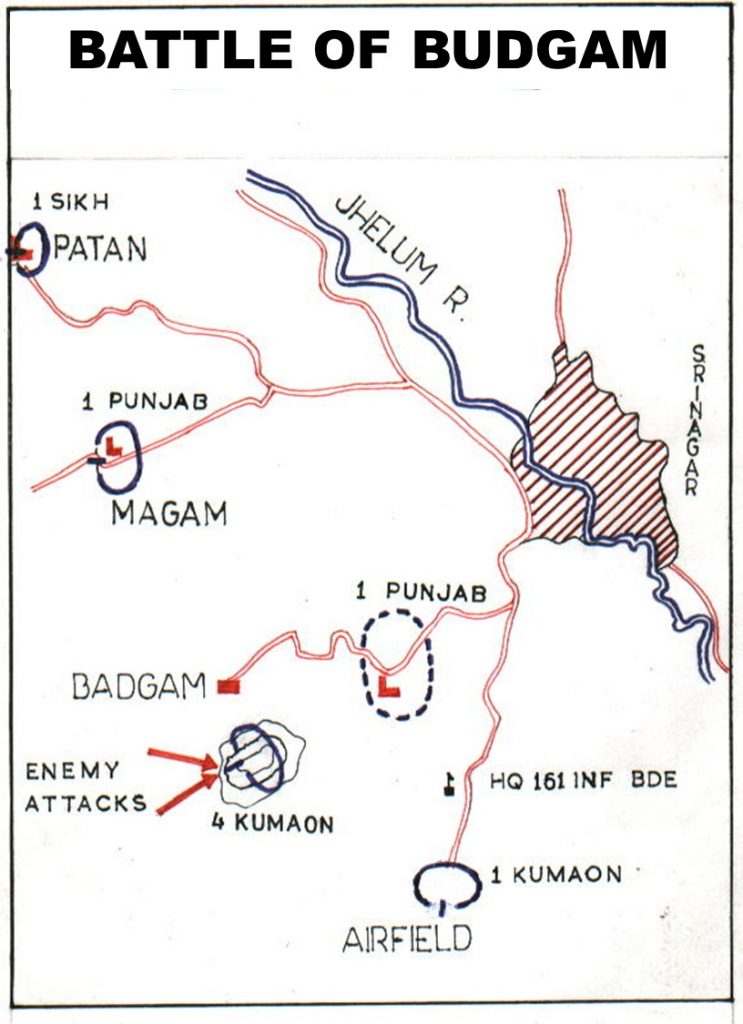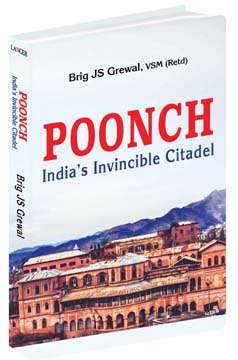Induction of HQs 161 Infantry Brigade and Additional Forces
In the next few days, Headquarters 161 Infantry Brigade arrived, and Brig JC Katoch, the Brigade Commander, arrived on 29 October. On 30 October, two howitzers 3.7 inch of Patiala State Forces were flown to Srinagar under Lt Jabar Jung Singh also of the Patiala State Forces, with written instructions to hand over the howitzers at Srinagar and return. He and his men were not to be involved in the ongoing operations. Both these howitzers were without the dial sights. As these howitzers were being unloaded, a group of raiders was sighted moving from the direction of Budgam towards the airfield. The howitzers were immediately brought into action and fired by sighting along the barrels, and the raiders were dispersed. Two more howitzers arrived on 31 October and these too were deployed in direct firing role till their dial sights arrived.
Brig Katoch was hit by a stray bullet while visiting 1 Sikh defence positions on 31 October. Being grievously wounded, he had to be evacuated. Then Brig LP Sen (Lionel Protip Sen), nicknamed ‘Bogey Sen’ arrived at Srinagar on 02 November to take over command of 161 Infantry Brigade. Commissioned in 16/10 Baluch Regiment and transferred to 8th Gurkha Rifles on India’s independence (in 1949, the spelling was changed from ‘Gurkha’ to the original ‘Gorkha’), Sen had been awarded the DSO in the Battle of Kangaw in Arakan during the Burma campaign. Later LP Sen was GOC-in-C Eastern Command during the 1962 Sino-Indian War. Thereafter, he was GOC-in-C Southern Command.
Airlift of 4 Kumaon
Now, it was a struggle to delay the enemy and gain time for adequate forces to arrive from Delhi. Hence, the available troops were employed for carrying out delaying actions in an aggressive and offensive manner. During October 1947, 4 Kumaon Battalion, operating in company groups in aid of civil authority in Delhi-Gurgaon area, was also ordered to be airlifted to Srinagar. Due to shortage of Dakota aircraft, it became necessary to airlift 4 Kumaon in company columns as follows:–
-
- D Company of 4 Kumaon under command Maj Somnath Sharma was airlifted on 31 October 1947.
- A Company of 4 Kumaon under command Capt HS Bolina was air lifted on 02 November 1947.
- Remainder 4 Kumaon was airlifted on 04 November 1947.
Battle of Budgam – 03 November 1947
The situation was critical and the troops had to be hastily deployed without any orientation. This deployment took the shape of offensive delaying actions. Intelligence reports had indicated that four columns of the raiders were closing onto Srinagar and were about to threaten the airfield. One enemy column moved from the west from Baramulla, the second enemy column moved from the southwest, the third enemy column moved from the northwest and the fourth enemy column moved from the north.
On 03 November, two companies of 4 Kumaon along with one company of 1 Kumaon were operating as fighting patrols. As planned, two companies of 4 Kumaon under command Maj Somnath Sharma were to move to the hills overlooking Budgam Village located almost three miles to the west of Srinagar Airfield and establish a firm base. One company of 1 Kumaon was to pass through this firm base, move cross country over a distance of eight miles, carry out search and destroy operations en route and establish contact with 1 Punjab at Magam. Maj Somnath Sharma led the Delta Company of 4 Kumaon, despite one arm being in plaster due to a fracture he had sustained earlier, and he established the firm base around 0930 hours.
The company sized patrol of 1 Kumaon encountered no enemy presence. Thereafter, Headquarters 161 infantry Brigade ordered the two companies of 4 Kumaon to start thinning out. By 1400 hours, Alfa Company of 4 Kumaon had moved back to Srinagar Airfield. Whereas, Maj Somnath Sharma, with his Delta Company was required to stay on till 1500 hours.
At about 1435 hours, Maj Somnath Sharma reported heavy enemy firing from some houses in Budgam Village. This firing was like a covering fire, aimed to distract attention from the main attack that was developing from the west. Soon thereafter, a large enemy force, over 700 strong appeared from a major depression to the west of his position and began to attack Delta Company position, supported by mortars and heavy automatic weapons fire. With the main road blocked against the enemy by 1 Sikh at Pattan, this large group of enemy raiders had moved cross country, apparently to put the Srinagar Airfield, the only link with the rest of India, out of action.
Realising the gravity of the situation, and the threat that would result to both Srinagar town and the airfield if he could not hold the enemy till he was reinforced, Maj Somnath Sharma urged his Delta Company to fight tenaciously. Completely outnumbered and with devastatingly accurate fire being brought to bear on their position, the company began to sustain heavy casualties. It was extremely daring when Maj Sharma exposed himself to the full fury of the enemy’s fire and laid out panels to guide own aircraft to their targets in support of his company.
Meanwhile, the enemy had reached very near. Delta Company, despite being heavily outnumbered, fought on and held the ground. In Number 11 Platoon, Sepoy Dewan Singh, who was the main Bren Gunner of Number 1 Section, picked up his bren gun and commenced firing from his hips, killing at least 15 persons of the enemy. Thereby, he could halt the enemy’s advance. Dewan Singh kept on firing till he was hit by a burst from an enemy bren gun on the chest and he collapsed and died. Delta Company held on for six hours against heavy odds till reinforcements had arrived and taken positions at Humhom so as to stem the tide of the enemy advance towards Srinagar.
Maj Sharma’s last radio message to the Brigade Commander: “The enemy is less than 50 yards from us. We are heavily outnumbered and are under devastating fire. I shall not withdraw an inch…”, was interrupted by a loud crash of a bursting mortar bomb, which killed him. This message was indicative of the tenacity and dedication of the heavily outnumbered Delta Company that was just holding a firm base and not deployed in well prepared, dug in defensive field fortifications. Devoid of artillery support, Delta Company was not meant to take on a full-fledged assault of over 700 enemy personnel.
Maj Somnath Sharma was posthumously awarded the first Param Vir Chakra of independent India and Sepoy Dewan Singh was bestowed with the MVC posthumously. Brig (later Lt Gen) LP Sen, DSO, Commander 161 Infantry Brigade had mentioned about Maj Somnath Sharma in his book, ‘Slender Was The Thread’: “He and his Company had fought a great battle against tremendous odds and their engagement with the enemy had disclosed an unknown and dangerous threat”.
The enemy had about 260 killed, including two officers and two JCOs and 320 persons wounded. Whereas, the Kumaonis suffered 15 killed and 32 wounded. If the troops at Budgam had not withstood the overwhelming assault of the raiders and not held on tenaciously, the Pakistanis may have acquired the Srinagar Airfield and the course of the 1947-48 War may have been different.
The story of the infantry soldier is an old and honourable one. An infantryman carries with him his home and often his grave. Somehow, he has to bring along the entire paraphernalia of fighting, as well as domesticated living, the grocery, the rations, immediate medical aid, the communication system. The infantryman has to manage during all crises. He must fight, eat and sleep in all weather conditions, rain or shine, with or without shelter. Though eating and resting are often ignored and forsaken during crises. The infantryman is vulnerable day and night. Death has its finger on him without a break.
It is no wonder that the morale of these high spirited infantrymen never falters. One of the prime reasons being that the officers too share the worries, discomforts, problems of their men and undergo the same hardships. The other reasons are superb camaraderie, regimentation, unit ethos and good training, which enable the infantrymen to emerge as winners. Time and again this story has been amply proven, and this time it was again proven by these infantry battalions, 1 Sikh, 4 Kumaon and 1 Kumaon.






